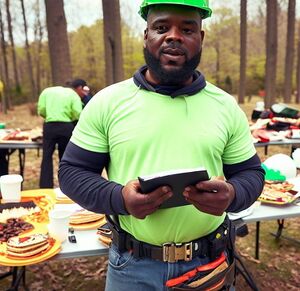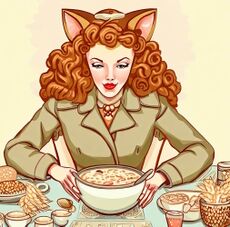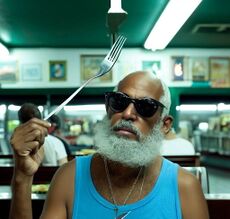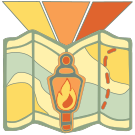Guide: Eating
 | |
| Guide: Eating | |
|---|---|
| Landmarks | Observe Parts of a Whole Notice Multiple Sensations Impermanence Basic Understanding Experimenting with Cravings Observe Duality and Connectedness |
Guides are a Pathway in The Map of Everyday Enlightenment which are typically articles about a particular time and place for meditative practices. Guides contain Landmarks that highlight examples of how this could work for you, as well as other explanations of how to make use of certain concepts or techniques. The Landmarks in Guides can be reviewed in the context of progress through the Realms of Everyday Enlightenment, and when used in that way, Guides become another way to decide where to go next.
The Guide to Eating highlights eating and drinking because they are everyday activities that provide rich opportunities for micro-meditative practice. Engaging with food and beverages mindfully allows us to explore Mindfulness and other themes such as Impermanence, cravings and even Nonduality - all of which add up to profound aspects of our relationship with the world and ourselves.
- Impermanence - The process of eating and drinking can serve as a powerful demonstration of the principle of impermanence. As we consume food or drink, we become intimately aware that these pleasures are transient. The taste, texture, aroma, and even the existence of the food or drink in our hands are fleeting.
- Non-Attachment - The knowledge that our meal or beverage will not last can elicit a range of emotions—from sadness and longing to a deeper appreciation of the present moment. This awareness can guide us to fully savor each bite or sip, knowing that this specific sensory experience will never recur in exactly the same way.
- Nonduality - At a basic level, consuming food and drink shows us how interconnected we are with the world, and how sense of identity can be fluid.
- Mindfulness - Paying attention to your sensory field while eating is a fantastic reminder of how simple it is to incorporate Mindfulness into your everyday experiences.
- Non-Seeking - The anticipation of eating or drinking something we enjoy is a potent example of craving, a fundamental aspect of the human condition. Cravings embody our desires for certain experiences and our aversions to others, often leading us to mental states of longing or dissatisfaction.
Use the following Landmarks as ways to integrate meditative practices into your everyday life and to check in on how you are progressing in your own journey.
Landmark: Experimenting with Cravings
 | |
| Landmark: Experimenting with Cravings | |
|---|---|
| Beacons | Adaptation |
| Realms | Enrollment |
| Lenses | Non-Seeking |
| Guides | Eating |
| Trails | Learn About Adaptation |
The Landmark of Experimenting with Cravings tests your experiences with cravings and how they affect your thoughts and emotions. This Landmark is within the Realm of Enrollment, and is part of the Beacon of Adaptation, more specifically the Lens of Non-Seeking.
Landmark Lookouts:
- Discovering Craving: Do you notice that there is a true craving to experience, that there's a strong feeling in your mind that you can "observe" in some way?
- Being Pulled vs Thinking: Can you distinguish between your craving (being pulled) and the mental thoughts that run through your head ("That chocolate looks so good")?
What better way to experiment with cravings than to take it literally, with some sort of sweet dessert...
- Select a snack or drink that you find particularly appealing. Make sure it's something you genuinely enjoy and look forward to having.
- Before you dive right in, take a moment to really look at your chosen treat. Notice its colors, its shape, its texture.
- Close your eyes and inhale. Can you smell the food or drink? What does it remind you of? Or maybe if it doesn't have a smell, test its weight or texture.
- Acknowledge the sense of anticipation building within you. You're eager to dig in, but don't just yet.
- Instead, explore that feeling of craving. It's like a tug in your gut, a mental image that won't go away, an expectation of pleasure.
- Take as much time as you need to really identify that there is a very real thought like "You should eat this now, go ahead and get started" and an emotion associated with that thought.
- Now, slowly start to eat or drink. Really focus on the experience - the texture, the taste, how it feels as you swallow.
- Take your time. With every bite or sip, observe how the intensity of your craving diminishes. What's replacing it? Satisfaction? A sense of calm?
- Reflect on this change. You went from craving to contentment, from anticipation to experience. And it all happened in a few moments.
- Carry this experience into your daily life. Whenever you find yourself desiring something, remember the snack. Recall how the craving came and went, and how the actual experience was just a series of moments, each passing away to make room for the next.
Landmark: Notice Multiple Sensations
 | |
| Landmark: Notice Multiple Sensations | |
|---|---|
| Beacons | Attention |
| Realms | Enrollment |
| Lenses | Mindfulness |
| Guides | Eating |
| Trails | Learn About Attention |
The Landmark of Notice Multiple Sensations starts out with simple Mindful practices of using smell, taste, and touch to Experience the Now. This Landmark is within the Realm of Enrollment, and is part of the Beacon of Attention, more specifically the Lens of Mindfulness.
Landmark Lookouts:
- Paying Attention to a Sensation: Can you practice paying attention to one sensation at a time - such as smelling your meal?
- Paying Attention to Multiple Sensations: Can you hold your attention on two or more sensations at a time - such as smelling your meal and feeling your smooth utensils? Can you feel the difference as you move back and forth between single sensations and multiple sensations?
- Sensations in The Now: Do you feel how the "weight" of sensations in the present is different than other thoughts which are not part of "Experiencing the Now"?
Doing this oatmeal example (or something similar), you'll be introduced to the first basic concepts of practicing Mindfulness, as part of simply eating something. There is a lot more to it, but just the simple act of paying attention to sensations is enough to help you "Experience the Now".
- When it's time for your next meal, sit down at your table with your plate of food.
- Before you begin eating, take a moment to appreciate the sight and smell of your food.
- As you pick up your fork or spoon, bring all your attention to the act of eating.
- Pay attention to every sensation of each bite - the flavors, the texture, the temperature, the muscles used in chewing and swallowing.
- With your attention fully on the experience of eating, notice that all of these sensations make up "The Now" - this is what is happening!
- When your mind wanders, notice where it goes, then gently guide it back to your eating.
- Even if your mind wanders a hundred times, bring it back a hundred times.
- Clean up after your meal, maintaining your focus on the present moment.
Landmark: Observe Duality and Connectedness
 | |
| Landmark: Observe Duality and Connectedness | |
|---|---|
| Beacons | Association |
| Realms | Enrollment |
| Lenses | Nonduality |
| Guides | Eating |
| Trails | Learn About Association |
The Landmark of Observe Duality and Connectedness gives you a chance to see Duality and then try to use the Lens of Nonduality to see things in a different way. This Landmark is within the Realm of Enrollment, and is part of the Beacon of Association, more specifically the Lens of Nonduality.
Landmark Lookouts:
- Noticing Duality: Can you make a point see things from the perspective of Duality, and that "that thing" is not "you"?
- Trying Nonduality: Given things you are connected with, such as food and drink, can you sense one clear moment where there isn't a meaningful distinction between those things and yourself?
The next time you're sipping your morning coffee, tea, or even a glass of water...
- Sit your drink down in front of you just for a few moments.
- Consider the drink and yourself. You are yourself. The drink is the drink, the cup is the cup. You are not the drink, and the drink is not you.
- Now for a moment, consider what makes up "you" - is it just your body and mind? If so, what about your hair and fingernails. What about the glasses you need, or the sweat coming out of your pores?
- At the moment when you can really sense that the question makes sense, reach out and put your hand around the drink.
- Reflect on how you, the drinker, and your drink are interconnected in this moment, just through that touch.
- As you pick up the drink and begin to enjoy the taste and feel of it going into your mouth, think again on how you are connected.
- Explore the sensation of the liquid passing down your throat, becoming a part of you. Feel the unity in that moment.
- Remind yourself that you're not separate from the world around you, just as the drink isn't separate from you.
- As you put down your cup, remember that experience - it's a small glimpse into the Nonduality that's inherent in all experiences.
Landmark: Impermanence Basic Understanding
 | |
| Landmark: Impermanence Basic Understanding | |
|---|---|
| Beacons | Adaptation |
| Realms | Enrollment |
| Lenses | Impermanence |
| Guides | Eating |
| Trails | Learn About Adaptation |
The Landmark of Impermanence Basic Understanding asks whether you are aware of the impermanence of all things at all times, that they are changing, decaying, and will not last. This Landmark is within the Realm of Enrollment, and is part of the Beacon of Adaptation, more specifically the Lens of Impermanence.
Landmark Lookouts:
- Notice Things Appear Solid: Are you able to notice how much we rely on the idea that things are solid and reliable?
- Think About How Things Won't Last: Can you feel a shift in perception as you think about something's impermanence, and how everything is going to change and decay over time?
A ready example of Impermanence can be found when you are drinking water.
- Next time you reach for your trusty water bottle, pause before you take a sip. We're going to try something.
- Hold the bottle in your hands. Really feel its weight, texture, temperature. Notice its shape, its color, its solidity.
- Seems permanent, right? It's a bottle, it's there, and it's real.
- Now, give it a little shake. Hear the water sloshing around inside? That's change right there. The water is moving, it's active. It's never the same from one moment to the next.
- Now take a sip. Feel the water going down your throat, refreshing and cool. The level of the water in the bottle has changed. The weight is different. Even the temperature might have changed slightly with your hand wrapped around it.
- So, even though it's still a bottle, it's not exactly the same bottle as it was a moment ago, is it?
- Continue with your work, but every time you reach for a sip, take a moment to notice these changes. The bottle gets lighter with each sip. The condensation on the outside might evaporate. The temperature shifts.
- Now take it a step further. Think about the water you're drinking. From your mouth, it goes into your system, hydrating you, becoming a part of you. So, in a way, the water’s journey continues, changing and flowing, just like everything else in this world.
- Through this everyday act, remind yourself: it's all in constant flux, even the seemingly solid and unchanging.
Landmark: Observe Parts of a Whole
 | |
| Landmark: Observe Parts of a Whole | |
|---|---|
| Beacons | Adaptation |
| Realms | Enrollment |
| Lenses | Special Composition |
| Guides | Eating |
The Landmark of Observe Parts of a Whole is a first step in seeing some common things as parts of a whole. This Landmark is within the Realm of Enrollment, and is part of the Beacon of Adaptation, more specifically the Lens of Special Composition.
Landmark Lookouts:
- Notice the Part: Can you see something and recognize that it is a "thing" but at the same time know it can be grouped together with other things to form a whole?
- Notice the Whole: Can you see something that is a "whole thing", and at the same time recognize that it has parts that are independent?
- Notice Other Wholes: Can you recognize that some "things" are part of more than one "whole", and some wholes share parts with other wholes?
To get a glimpse into the flexible nature of our concept of "parts and whole," we can mindfully observe the things around us during any meal or snack. Try each of these at different times and see if you get that glimpse. Take your time to think about each of these ideas, and don't necessarily do all of these during one meal.
- When you use a fork, do you consider that you have a handle, and the tines of the fork? There are really two halves to the fork in terms of utility, and some forks might even have a wooden handle and metal tines. Beyond that, you may think of the tines as one useful side of the fork, but try stabbing something small with just one of the tines. For that one moment, can you sense that each of the tines is its own thing? For a fork, it seems obvious it is "the whole" because it is forged from one piece of metal. However, each part can be considered alone as well.
- What is your drink, or more specifically, what about the drink you see in front of you is necessary to maintain its identity? We know liquid is made of molecules, or even more simplistically "drops". But what happens if you take a sip of your drink? Is it now a new drink? Was that sip part of the drink? If so, it wasn't a mandatory part of it.
- Other things around you such as chairs and tables are clearly made of parts, but we rarely need to think about that. But once you start listing the parts of a chair, it's very obvious that the parts (the legs, seat, back) are fairly uninteresting compared to the whole chair itself.
- A sandwich is the perfect example of something that is both "the whole" and "the parts" at all times. A sandwich (or anything comparable) is so dependent on the parts being distinctive, but working in harmony. As you eat, think about what it would be like if one of the toppings wasn't there, or if it was all blended up first, or if you were to eat each part separately. The experience wouldn't be the same at all.
